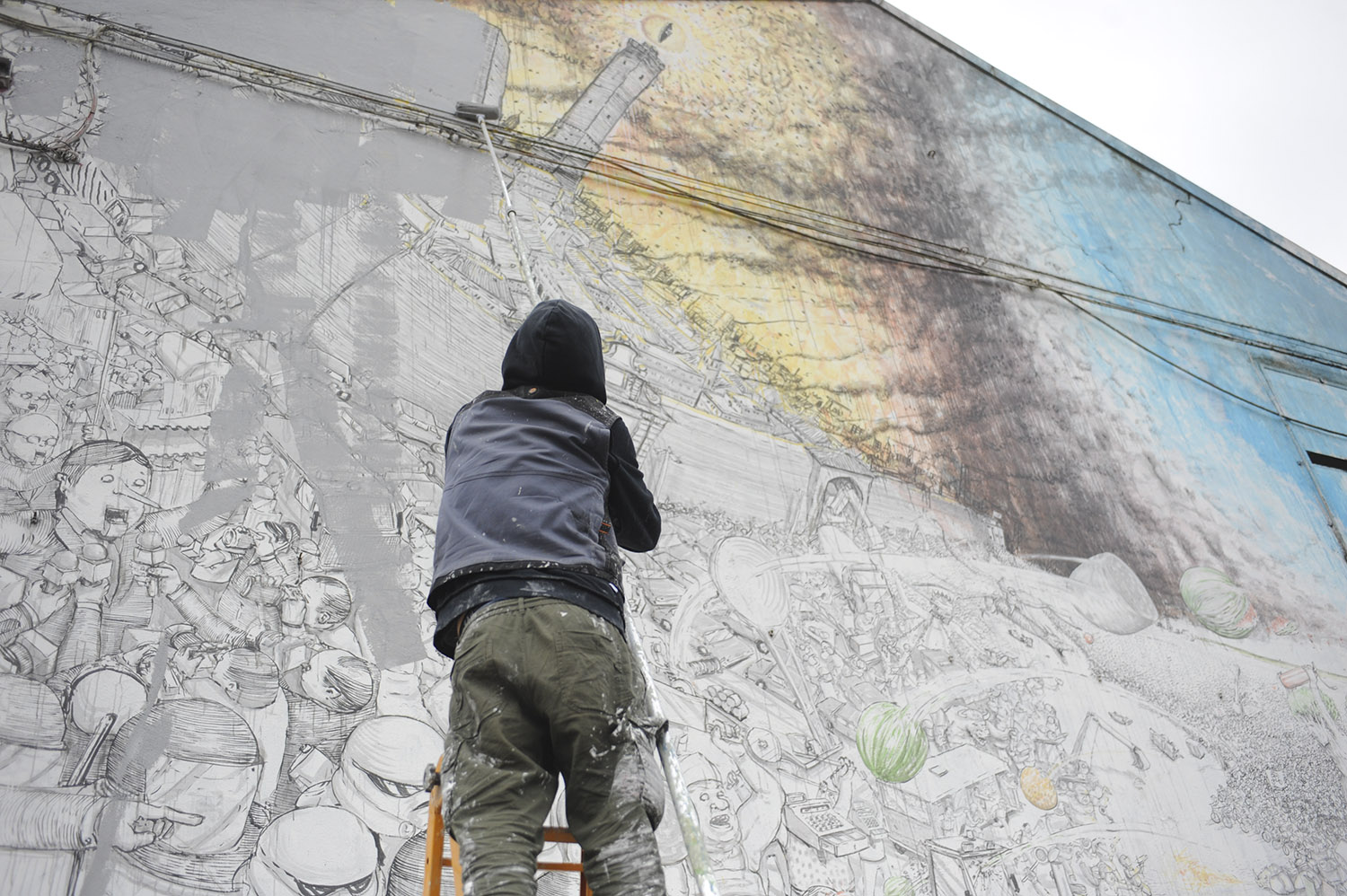
Painting over a mural by Blu in Bologna (photo by Michele Lapini via Blu‘s website)
On Saturday night, the renowned and mysterious Italian street artist Blu went on an art-destroying spree through the streets of Bologna. The work he erased was his own — with the help of activist groups XM24 and Crash, Blu covered 20 years’ worth of massive, colorful murals with gray paint.
The gesture was an act of protest against an upcoming exhibition, Street Art: Banksy & Co., which opens Friday in Bologna’s historic Palazzo Pepoli. The exhibition, co-organized by the privately funded cultural institution Genus Bononiae and the Arthemisia Group, features 250 works of street art, some of which were removed from their original public locations without the artists’ consent. The show was curated by one of the city’s wealthiest patrons, Fabio Roversi Monaco, president of both the Academy of Fine Arts and the powerful Banca Imi.
When Blu learned that the exhibition will include some of his own work, Genus Bononiae’s attempt to “[salvage street art] from demolition and [preserve it] from the injuries of time,” as they put it, dramatically backfired.
Blu’s destruction of his remaining murals in Bologna, as the leftist artist collective Wu Mingexplained on its blog (per the artist’s request), keeps it away from private institutions. The gesture is intended to expose the hypocrisy of a city that “on the one hand criminalizes graffiti, puts 16-year-old writers on trial, praises ‘urban decorum,’ and on the other celebrates herself as the cradle of street art and wants to retrieve it for valorization on the market.” Just last month, another globetrotting Italian street artist, Alice Pasquini, was fined€800 (~$889) for a graffiti-related offense. In this context, the collective wrote, “the only thing left to do is [to make] these paintings disappear, to snatch them from those claws, to make hoarding impossible.”
We reached out to Blu and the Wu Ming Foundation for more commentary, but as the Wu Ming Foundation made clear in a blunt email, Blu never does interviews:
Blu never talks to journalists, he never gives interviews, he doesn’t even write about the meaning of his work or his actions or “how it feels,” nothing like that. He only draws murals or, in this case, he erases them. Silently. That’s why he asked us to write a statement about his latest action, which we did. However, the agreement we have with Blu is: no interviews, and we respect that. Sorry, we cannot help you.
Blu and his comrades taped up said statement at the sites of the destroyed murals, and also posted it online. “Seeing street art exhibited in a museum is paradoxical and grotesque,” they wrote of Banksy and Co. “This ‘street art’ exhibition is representative of a model of urban space that we must fight, a model based on private accumulation which commodifies life and creativity for the profits of the usual few people.”
This isn’t Blu’s first brush with censorship, self-inflicted or otherwise. In 2012, a mural he created as part of the Los Angeles Museum of Contemporary Art’s Art in the Streetsexhibition was whitewashed (prompting him to repeatedly break his own “never talks to journalists” rule). In 2014, he and artist Lutz Henke (with some help) painted over an iconic, collaborative mural in Berlin’s Kreuzberg neighborhood to protest the area’s gentrification.
Blu’s desire to retain control of what uses his street art is put toward — and keep it out of the hands of those seeking to profit from it — echoes Banksy’s reaction to the Sincura Art Club‘s 2014 auction of his “sensitively salvaged” works of street art. “This show has got nothing to do with me and I think it’s disgusting people are allowed to go around displaying art on walls without getting permission,” Banksy wrote at the time in a statement on his website.

No hay comentarios:
Publicar un comentario